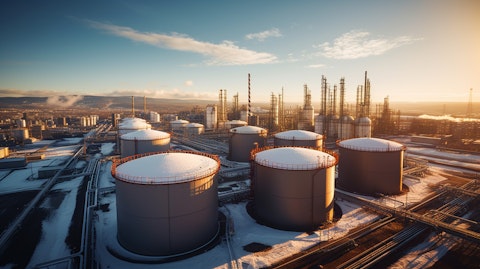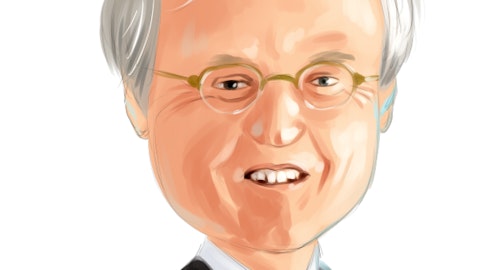DMC Global Inc. (NASDAQ:BOOM) Q3 2023 Earnings Call Transcript November 5, 2023
Operator: Greetings and welcome to the DMC Global Third Quarter Earnings Call. At this time, all participants are in a listen-only mode. A brief question-and-answer session will follow the formal presentation. [Operator Instructions] As a reminder, this conference is being recorded. It is now my pleasure to introduce your host, Geoff High, Vice President of Investor Relations. Thank you, Geoff. You may begin.
Geoff High: Hello and welcome to DMC’s third quarter conference call. Presenting today are DMC’s Chief Executive Officer, Mike Kuta; and Chief Financial Officer, Eric Walter. I’d like to remind everyone that matters discussed during this call may include forward-looking statements that are based on our estimates, projections, and assumptions as of today’s date and are subject to risks and uncertainties that are disclosed in our filings with the SEC. Our business is subject to certain risks that could cause actual results to differ materially from those anticipated in our forward-looking statements. DMC assumes no obligation to update forward-looking statements that become untrue because of subsequent events. Today’s earnings release and a related presentation on our third quarter performance are available on the Investor page of our website, located at dmcglobal.com.
A webcast replay of today’s presentation will be available at our website shortly after the conclusion of this call. And with that, I’ll now turn the call over to Michael Kuta. Mike?
Mike Kuta: Good afternoon, everyone. DMC’s third quarter was marked by both strategic accomplishments and operational challenges. We reported consolidated sales of $172 million, flat versus last year’s third quarter and below our prior forecasts. Sales at Arcadia, our building products business, were $72 million, down 11% year-over-year. Steady customer activity at Arcadia’s primary regional service centers, as well as healthy sales at its ultra-high-end residential business, were offset by pricing pressure associated with lower raw material costs, soft demand for commercial interior products, and a brief operational slowdown related to the transition to a new ERP system. DynaEnergetics, our energy products business, reported sales of $73 million, up 4% year-over-year, but down 14% sequentially.
The US drilling and completion industry idled additional rigs and frac crews during the quarter, and the Energy Information Administration reported a 10% sequential decline in US well completions. Dyna’s US sales also were impacted by customer project delays late in the quarter. Soft sales in the US were partially offset by continued strong demand at Dyna’s international business, which expects to deliver record full-year sales in 2023. Sales in NobelClad, our composite metals business, improved 18% to $28 million versus last year’s third quarter. NobelClad’s results reflect outstanding execution on a demanding petrochemical project, as well as continued strong demand for pressure vessel plates and specialized transition joints. NobelClad ended the third quarter with an order backlog of $61 million versus $64 million at the end of the second quarter.
Rolling 12-month bookings were $111 million, up sequentially from $108 million, and the book-to-bill ratio was 1.1. Our consolidated third quarter adjusted EBITDA attributable to DMC was $25 million or 14.3% of sales, and was within our forecasted range, despite the lower-than-expected sales. DMC’s long-term focus is to position each of its businesses to deliver adjusted EBITDA margins of 20% or greater. Our businesses are structuring their operations and making the necessary investments to achieve these objectives on a consistent basis. At Arcadia, additional paint capacity, a new ERP system, and a series of operational enhancements and growth initiatives are expected to drive long-term improvements in sales and profitability. In the North American oil and gas market, where Dyna generates approximately 85% of its sales, we expect continued consolidation by leading operators will sharpen the completion industry’s focus on safety, technology, and efficiency.
Dyna, which had a challenging third quarter, has taken a number of steps to streamline its cost structure and will incur roughly $1 million in associated onetime expenses during the fourth quarter. These cost reductions are expected to result in approximately $3 million in annualized savings. Dyna also is implementing a series of operational excellence initiatives designed to enhance the safety, quality, and reliability of its perforating systems. These initiatives include greater use of automation throughout Dyna’s manufacturing and assembly facilities. NobelClad is focused on expanding the market for its DetaPipe and Cylindra product lines and is pursuing emerging opportunities in lithium and hydrogen production. We expect 2024 will be another strong year at NobelClad.

As Eric will discuss in a moment, much improved free cash flow led to further improvements in our financial position during the third quarter. I remain encouraged by the strengths of our differentiated manufacturing businesses and our prospects for profitable long-term growth. DMC’s achievements would not be possible without the efforts of our talented workforce and I want to acknowledge all of our employees for their hard work and dedication. I also want to thank our customers for their loyalty. With that, I’ll turn the call over to Eric for a closer look at our third quarter financial results and our guidance for the fourth quarter. Eric?
Eric Walter: Thanks Mike. As previously mentioned, our consolidated third quarter sales were $172 million, down 1% from the third quarter last year. Consolidated gross margin was 30.6%, up 110 basis points from our 2022 third quarter, due to a more favorable project mix at NobelClad combined with margin recovery at Arcadia. Our third quarter SG&A expense of $29 million was 16.7% of sales, down from 17.5% in the third quarter of last year, driven mostly by lower litigation expense at Dyna. Third quarter adjusted EBITDA attributable to DMC increased by 13% year-over-year to $25 million. The improvement was primarily driven by higher sales and gross margin at NobelClad. Inclusive of the Arcadia non-controlling interest, consolidated adjusted EBITDA was $30 million, or 17.4% of sales, up 220 basis points versus the prior year quarter.
At the business level, Arcadia reported third quarter adjusted EBITDA of $13 million, of which $8 million, or 60%, was attributable to DMC. Compared with the prior year, Arcadia’s adjusted EBITDA rose 11% and expanded 390 basis points as a percentage of sales. While Arcadia’s pricing has moderated this year, aluminum costs have declined at a faster pace and contributed to the recovery in EBITDA margin. Dyna reported third quarter adjusted EBITDA of $13 million or 17.2% of sales. Lower absorption of manufacturing overhead costs and a less favorable customer mix led to a sequential and year-over-year margin contraction. NobelClad reported adjusted EBITDA of $6 million, which was 23.1% of sales and up 850 basis points compared to the third quarter of 2022.
EBITDA margin improved due to a more favorable project mix, better absorption of fixed manufacturing overhead costs, and lower SG&A. Adjusted net income attributable to DMC was $10 million during the third quarter of 2023. Adjusted EPS attributable to DMC was $0.50, up over 40% compared to last year’s third quarter. Underlying improvements in gross margin and SG&A more than offset relatively flat sales performance year-over-year. During the quarter, DMC generated free cash flow of $22 million, which was the highest quarterly level since 2019, and was up from $17 million in last year’s third quarter. We used this year’s third quarter free cash flow primarily for principal payments on our long-term debt, distributions to our Arcadia joint venture partner, and an investment in marketable securities, which will be used as part of our deleveraging efforts.
In terms of liquidity, we ended the third quarter with cash and marketable securities of $36 million and had no amounts outstanding under our $50 million revolver. Our debt to adjusted EBITDA leverage ratio was 1.26 at the end of the third quarter, which was well below our covenant threshold of 3.0 and represents the seventh consecutive quarter of deleveraging the balance sheet. On a pro forma net debt basis, after subtracting cash and marketable securities, our leverage ratio was 0.89 at the end of the third quarter. Now, turning to fourth quarter guidance. Consolidated sales are expected in a range of $170 million to $180 million versus the $172 million reported last quarter. We anticipate Arcadia’s fourth quarter sales volume to be relatively flat sequentially.
Dyna expects to maintain its share in its core North American markets, but does anticipate overall activity levels will remain soft, due in part to year-end seasonality. NobelClad sales are expected to accelerate sequentially as the business benefits from delivery of key projects already in its backlog. Consolidated gross margin is expected in a range of 28% to 30% compared with the 30.6% in the third quarter. Gross margin at Arcadia and Dyna is expected to be relatively flat quarter-over-quarter, while NobelClad’s gross margin will moderate based on project mix. Consolidated fourth quarter SG&A expense is expected to range from $28 million to $29 million versus the $29 million reported in the third quarter. Fourth quarter adjusted EBITDA attributable to DMC is expected to be in a range of $20 million to $24 million versus $25 million in the third quarter.
Finally, we expect fourth quarter capital expenditures will be in a range of $8 million to $10 million. With that, we’re ready to take any questions. Operator?
See also 10 Countries with Most Nuclear Weapons in the World and 20 Most Common Places to Get Kidnapped.
Q&A Session
Follow Dmc Global Inc. (NASDAQ:BOOM)
Follow Dmc Global Inc. (NASDAQ:BOOM)
Operator: [Operator Instructions] Thank you. Our first question is from Gerry Sweeney with ROTH Capital Partners. Please proceed with your question.
Gerry Sweeney: Good afternoon Mike, Eric, Geoff. Thanks for taking my call.
Mike Kuta: Hey Gerry.
Gerry Sweeney: Starting with Arcadia, can you break out, you have the service center work, which I think, for lack of a better term, that sticks that go to a lot of sort of storefronts, different pedestal type operations of buildings, ultra-high-end, and then the commercial interiors. It sounded like the commercial interior business was slow, but I wanted to see how that compared with the other two businesses. Were the other two businesses in line? Was it entirely commercial interiors? Just wanted to dig in a little deeper on that front.
Mike Kuta: Yes. thanks Gerry. So, the commercial interiors, which is our smallest business, we see that within Arcadia. That’s in a valley right now, at least the work that we’re seeing with commercial interior buildout. The commercial exteriors business has been relatively, I’d call it, flat, resilient, seeing a little bit of softening in some of the longer cycle projects. But the short cycle projects, which, there’s a lot of diversification in our end markets there, is holding up pretty well.
Gerry Sweeney: Got it. And I wanted to talk about — you’ve been at capacity in that business, and you also have — you’ve added areas like Houston and Dallas, and these are my words, not yours, maybe underserved because of capacity issues. You’re adding paint capacity to sort of expand that. How do we look at some of the little softness on the longer projects versus short cycle versus adding capacity and sort of maybe investing in new locations? How does that all come together in terms of growth and opportunities?
Mike Kuta: Yes. On the West Coast, we’re definitely in a bit of a softer market. You look at the ABI readings, sub 45, but there’s still a lot of opportunity in a lot of our markets where we’re still seeing some strength. So, we’re moving around some of the project business into some of our service centers that might be seeing a little less activity and pushing on the gas pedal on areas where activity remains strong. So, I think that if we go into a softer market, I think there’s going to be an opportunity to drive the topline at still favorable margins. So, this paint capacity that we’re putting in place, we’ve done some industrial engineering there. We’ve got more of a paint capacity we can put in by mid-next year. I think we’re going to be able to sell it through.
Gerry Sweeney: Got it. And then, just last question on Acadia. How much was sort of the ERP — how much did the ERP implementation impact the quarter?
Eric Walter: Yes. Gerry, so we probably lost two to three days with our service center or short cycle business, and that unfortunately were canceled orders. So they’re not going to come into Q4. So, when you think about the impact to Q3 revenues, that was as meaningful of an impact as the other two drivers that we talked about.
Gerry Sweeney: Got it. So, a third, a third, a third. Got it. One question on Dyna, and then I don’t want to monopolize this. But I think you said completions IEA or EIA were down 10%. I think you were down 14%. In this market, obviously, things have slowed down. Everybody is looking at 2024 expectations, completions are up. Are we sort of in this market where a similar market for the third quarter, maybe even the fourth quarter that was similar to a couple of years ago where everybody knows the benefits of Dyna? It’s a premium product, but they’ve got crews and they’re sort of idling them a little bit. There’s no sense in paying up for the benefit that Dyna brings when there’s a little bit of softness and they have capacity. Is that what we’re potentially seeing?
Mike Kuta: Yes, I think, Gerry, what we’re seeing is, we just finished a pretty strong October, and I think we’ll see some seasonality at the end of the year. So, I think, Dyna is going to look in the fourth quarter, maybe similar to the third quarter that’s in our guidance. Eric, you can speak to that, but I think some of the initiatives we’re taking in DynaEnergetics are really going to drive results also as we go into 2024, and I think we’ll see a bit better of a market as well.
Eric Walter: Yes. And I think just to augment what Mike said, so some of the softness in Q3 was due to some projects that were pushed out. We believe that those projects are going to materialize in Q4. So, while the topline may be relatively flat, we haven’t lost that business, it just skipped out one quarter.
Gerry Sweeney: Got it. That’s helpful too. Okay, I’ll jump back in line. Thank you.
Mike Kuta: Thanks Gerry.
Operator: Thank you. Our next question is from Stephen Gengaro with Stifel. Please proceed with your question.
Stephen Gengaro: Thanks. Good afternoon everybody. I guess, a couple on the Dyna side. The first is just around what you’re seeing from a pricing perspective now versus a couple months ago and any expectations going forward?
Eric Walter: Yes. So, we cited sales down, absorption, customer and pricing mix. So, you’ve seen a little bit more pressure on price with the market down 10%. Hopefully, we’re going to see pricing stabilize here. And I think, going into 2024, we’ll see where things shake out, but I would think that we’d be in a pretty stable pricing environment.
Stephen Gengaro: Okay. Thank you. And when we think about what has gone on the US land side and particularly the pressure pumpers have consolidated, you’ve got four holding a lot of the capacity. More of them have their own internal wireline capacity. Is that — how should we think about the integration of wireline and frac within — or the impact it has on you? Is it positive? Is it negative? Is it neutral? Is there any read-throughs from that?


